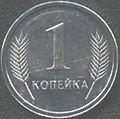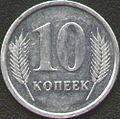Transnistrian ruble
| ruble transnistrene Template:Ro icon рубле транснистренеTemplate:Mo icon приднестровский рубль Template:Ru icon придністровський рубль Template:Uk icon | |
|---|---|
 2007 issue Transnistrian ruble banknotes | |
| Unit | |
| Symbol | |
| Denominations | |
| Subunit | |
| 1/100 | kopecks |
| Banknotes | 1, 5, 10, 25, 50, 100, 200, 500 rubles |
| Coins | 1, 5, 10, 25, 50 kopecks and 1, 3, 5 and 10 rubles |
| Demographics | |
| User(s) | |
| Issuance | |
| Central bank | Trans-Dniester Republican Bank |
| Website | http://www.cbpmr.net/ |
| Valuation | |
| Inflation | 10.83% |
| Source | "Inflation", Pridnestrovie, 2006 |
The ruble is the currency of Transnistria and is divided into 100 kopecks. Since Transnistria is a state with limited international recognition and considered as part of Moldova, its currency has no ISO 4217 code. However, unofficially some Transnistrian organisations such as Agroprombank and Gazprombank used the code PRB, a code that would otherwise be reserved for Puerto Rico (ISO 3166-1 country code PR). The Trans-Dniester Republican Bank sometimes uses the code RUP.[1]
First ruble (1994)
Soviet banknotes were used in the Trans-Dniester Moldavian Republic after its formation in 1990. When the former Soviet republics began issuing their own currencies, Transnistria was flooded with Soviet rubles. In an attempt to protect its financial system, in July 1993 the government bought used Goznak-printed Soviet and Russian notes dated 1961–1992 which it modified by adhering stamps bearing the image of General Alexander Vasilyevich Suvorov, founder of Tiraspol. These stamped notes replaced unstamped Soviet and Russian notes at par. It is thought that most uncirculated notes bearing these stickers were created after 1994 specifically for collectors.[2]
Second ruble (1994–2000)
The first, provisional issues were replaced in August 1994 by a new ruble, equal to 1000 old rubles. This currency consisted solely of banknotes and suffered from high inflation, necessitating the issue of notes overstamped with higher denominations. Although issued in 1994, some notes (50 to 5000 rubles) were issued dated 1993.
Banknotes
| 1994 Series | ||||||||
|---|---|---|---|---|---|---|---|---|
| Value | Dimensions | Main Colour | Images | Description | Date of | |||
| Obverse | Reverse | Obverse | Reverse | printing | issue | |||
| 1 ruble | ?? | Green | Alexander Suvorov | Transnistrian Supreme Soviet | 1994 | 1994 | ||
| 5 rubles | Blue | |||||||
| 10 rubles | Red | |||||||
| 50 rubles | Dull Green | Equestrian Statue of Alexander Suvorov in Tiraspol | 1993 | 1993 | ||||
| 100 rubles | Brown | 
| ||||||
| 200 rubles | Red violet | Equestrian Statue of Alexander Suvorov in Tiraspol | Transnistrian Supreme Soviet | 1993 | 1994 | |||
| 500 rubles | Blue | Equestrian Statue of Alexander Suvorov in Tiraspol | Transnistrian Supreme Soviet | 1993 | 1994 | |||
| 1000 rubles | Purple and red-violet | Equestrian Statue of Alexander Suvorov in Tiraspol | Transnistrian Supreme Soviet | 1993 | 1994 | |||
| 1000 rubles | Purple | Alexander Suvorov | Transnistrian Supreme Soviet | 1994 | 1994 | |||
| 5000 rubles | Black on deep olive-green | Equestrian Statue of Alexander Suvorov in Tiraspol | Transnistrian Supreme Soviet | 1993 | 1995 | |||
| 10,000 rubles | Green | Alexander Suvorov overprinted on a 1 ruble note with "1oooo" only on front | Transnistrian Supreme Soviet | 1994 | 1996 | |||
| 10,000 rubles | Green | Alexander Suvorov overprinted on 10 ruble note with "10ooo" on front and back | Transnistrian Supreme Soviet | 1994 | 1998 | |||
| 50,000 rubles | Brown | Bohdan Khmelnytsky | Drama and Comedy theatre, Tiraspol | 1995 | 1995 | |||
| 50,000 rubles | Blue | Alexander Suvorov overprinted on a 5 ruble note, with a holographic seal containing his equestrian statue in Tiraspol and the value "50000" on front | Transnistrian Supreme Soviet | 1994 | 1996 | |||
| 50,000 rubles | Blue | Alexander Suvorov overprinted on a 5 ruble note with "50ooo" on front and back | Transnistrian Supreme Soviet | 1994 | 1996 | |||
| 100,000 rubles | Red | Alexander Suvorov overprinted on a 10 ruble note with "100ooo" on front and back | Transnistrian Supreme Soviet | 1994 | 1996 | |||
| 500,000 rubles | Purple on yellow | Equestrian Statue of Alexander Suvorov in Tiraspol | Transnistrian Supreme Soviet | 1997 | 1997 | |||
Third ruble (2000–present)
In 2000, a new ruble was introduced at a rate of 1 new ruble = 1,000,000 old rubles. This new currency consists of both coins and banknotes.
Coins
-
1 kopeck obverse
-
1 kopeck reverse
-
10 kopecks obverse
-
all 2000 coins
-
5 kopecks, 2005
-
10 kopecks, 2005
Coins are of 1 to 50 kopecks and are made from aluminium or copper-zinc and are similar to Soviet-era coinage. The 1 kopeck coins were withdrawn from circulation in January 2009.
On August 22, 2014, the Transnistrian Republican Bank issued coins made of composite materials and come in denominations of 1-, 3-, 5- and 10 rubles.[3][4]
-
3 Rubles
-
5 Rubles
-
10 Rubles
Commemorative coins

Since 2000 the Transnistrian Republican Bank has issued a large number of commercial commemorative coins made from silver and gold. Their mintage numbers were very low, ranging between 500 and 5,000. Topics included for example "Ancient fortresses on the river Dniester", "The Outstanding people Transdniestria" and "Red book Transdniestria". A complete listing can be found on the website ([1]) of the Transnistrian Republican Bank.
Mint
When it was founded, Transnistria did not have its own mint. Thus a foreign mint had to be found to strike Transnistrian coins. The Mint of Poland (Mennica Polska) in Warsaw was selected for the job and accepted it.[5] Coins dated 2000 were struck in Warsaw and transported via Ukraine to Transnistria in trucks belonging to the Transnistrian Republican Bank.
The Moldovan government was not pleased with this situation, since they viewed it as a de facto recognition of Transnistria. In October 2001 Moldovan president Vladimir Voronin addressed the issue with his Polish counterpart.[6]
The Polska Mennica responded to the criticism by stating that because the Transnistrian ruble is not internationally recognized as a currency, they were in fact producing tokens (and not coins), which is normal business for mints.[7]
The conflict came to a height when in December 2004 Ukrainian customs confiscated a truck with US$117,000 worth of Transnistrian coins near Lviv. The coins were handed over to the Moldovan authorities, who in response again protested with the Polish government.
The Polish Ministry of Foreign Affairs en state property wrote another letter to the Polish mint in April 2005. They warned that continued production of Transnistrian coins would endanger relations with Ukraine and Moldova and damage the image of Poland abroad. The Polish mint bowed to the pressure and cancelled its contract with Transnistria the same month.
For Transnistria there was then no other solution but to strike future coins themselves. Thus on 18 November 2005 the Tiraspol Mint (Тираспольский монетный двор) was opened in the presence of President Igor Smirnov.
Banknotes
Notes are issued by the Transnistrian Republican Bank (Приднестровский Республиканский Банк) in denominations of 1 to 500 rubles.
2000 Series
| 2000 Series | ||||||||
|---|---|---|---|---|---|---|---|---|
| Value | Dimensions | Main Colour | Images | Description | Date of | |||
| Obverse | Reverse | Obverse | Reverse | printing | issue | |||
| 1 ruble | 129 × 56 mm | Orange | Alexander Suvorov | Chiţcani monument | 2000 | 2000 | ||
| 5 rubles | Blue | KVINT brandy factory | ||||||
| 10 rubles | Brown | Novo-Nyametsky Monastery | ||||||
| 25 rubles | Red | Bender Castle | ||||||
| 50 rubles | 129 × 60 mm | Green | Taras Shevchenko | Presidential palace / government building in Tiraspol | ||||
| 100 rubles | Purple | Dimitrie Cantemir | The Cathedral of Christmas, Tiraspol | |||||
| 200 rubles | 135 × 64 mm | Dark brown | Peter Rumyantsev-Zadunaisky | Battle of Gross-Jägersdorf, July 21, 1757 | 2004 | 2004 2012 | ||
| 500 rubles | 140 × 68 mm | Dull green | Catherine II | The decree of the creation of Tiraspol by Catherine II, and the plan of a fortress | ||||
2007 Series
In 2007 a new series replaced the above banknotes of denominations 1 to 100 rubles. The new notes have the same themes but a new design.
| 2007 Series | ||||||||
|---|---|---|---|---|---|---|---|---|
| Value | Dimensions | Main Colour | Images | Description | Date of | |||
| Obverse | Reverse | Obverse | Reverse | printing | issue | |||
| 1 ruble | 129 × 55 mm | Brown | Alexander Suvorov | Chiţcani monument | 2007 | 2007 2012 | ||
| 5 rubles | Blue | KVINT brandy factory | ||||||
| 10 rubles | Green/Black | Novo-Nyametsky Monastery | ||||||
| 25 rubles | Red | Bender Castle | ||||||
| 50 rubles | 129 x 56 mm | Cyan | Taras Shevchenko | Presidential palace / government building in Tiraspol | ||||
| 100 rubles | Purple | Dimitrie Cantemir | The Cathedral of Christmas, Tiraspol | |||||
Exchange rates
Buy
USD 11.00
EUR 12.00
RUS 0.210
UAH 0.430
MDL 0.580
CHF 10.40
GBP 14.81
Sell
USD 11.15
EUR 12.85
RUS 0.228
UAH 0.560
MDL 0.650
CHF 13.50
GBP 17.80[8]
Acceptance outside of Transnistria
The Transnistrian Ruble is generally not accepted as currency outside of Transnistria, though some bus companies with connections to Tiraspol accept Transnistrian rubles at the Chișinău bus station.
References
- ^ Условия проведения операций "валютный своп" USD/RUP (in Russian), Trans-Dniester Republican Bank, retrieved 2011-09-21
- ^ Trans-Dniester Republican Bank. Available at:http://www.cbpmr.net/?id=33&lang=en
- ^ Transnistria 2014 - New coin family in synthetic material World Coin News (worldcoinnews.blogspot.com). Retrieved on 2014-08-22.
- ^ Official poster of Transnistrian Republican Bank with images and description.
- ^ http://wyborcza.pl/1,75248,2490728.html
- ^ http://www.transnistria.info/independent-transnistria-news/tiraspol-designated-the-arrest-of-a-batch-of-the-transdniestrian-coins-as-a-provocation.html
- ^ http://www.mennica.com.pl/dla-inwestorow/sprawozdania-rn.html, sprawozdania Rady Nadzorczej Mennicy (2005).
- ^ http://www.anothertriptorecall.com/transnistria-exchange-rates-and-how-to-access-cash/









